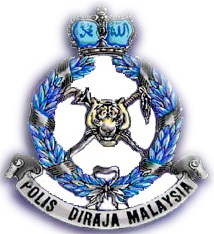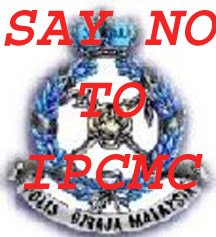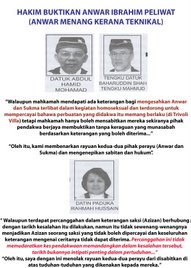






American journalists who doubted Ali Shalal (picture below) as the "Prisoner in the Hood" -- standing on a box, electrical wires attached to his outstretched arms, electrocuted thrice -- should have come listen to his gripping testimony at the PGPO "Criminalising War" conference in Kuala Lumpur yesterday. Ask him some probing questions, if necessary, but the American atrocities in Abu Ghraib remain a war crime story to be told and re-told.
Significantly, Ali Shalal chose to speak from a text sworn under Malaysia's Statutory Declaration Act 1960, before a Commissioner for Oaths in Kuala Lumpur.
In the statutory declaration, he used the name entered in his Iraqi passport: Abbas Z. Abid.
The audience that filled Dewan Merdeka to the brinks held their breath listening to Ali Shalal, who gave a live testimony of torture as a direct-hit victim while he was custody in the infamous Aby Ghraib prison, in the US-occupied Iraq.
His statutory declaration will be deposited with the War Crimes Commission as one of the petitions from War Crime Victims. Subsequently, Ali Shalal's petition is expected to be forwarded for deliberation by the War Crimes Tribunal, which will begin its preliminary deliberation later in the afternoon.
When the War Crimes Commission sits for the preliminary proceedings at 9.00am this morning , War Crimes victims will present their petitions and give their witnesses' accounts.
They include war crimes victims from the war in Afghanistan aka The Global War on Terror; war in Iraq including the Fallujah Massacre; war in Lebanon, and war in Palestine.
New York Times retracted story
March 11 last year, The New York Times ran a dramatic front-page story that matched the infamous photo: the chilling shot of an Abu Ghraib prisoner, hooded, standing on a box, electrical wires attached to his outstretched arms.
The "Prisoner in the Hood" was identified by the NY Times as Ali Shalal Qaissi.
However, the story was challenged by online magazine Salon. On March 18, the NY Times acknowledged that its story was flat wrong, and the paper admitted that the prisoner in the photograph was not Qaissi, who has reportedly admitted to the falsehood.
In an editor's note, the NY Times said "the Times did not adequately research Mr. Qaissi's insistence that he was the man in the photograph" and "should have been more persistent in seeking comment from the military.
And the story died instantly in America's media.
The matter was raised at the pre-Conference press briefing on Sunday, to which Dr Mahathir, chairman of PGPO, answered: "The US military will naturally deny everything because you would not know who is behind the hood. But we believe that Ali Shalal is the man behind the hood that you saw in the picture."
The torture
When Ali Shalal took the podium yesterday, he displayed several video clips of the tortures in Abu Ghraib, laid with soundtracks of Iraqi music. In the dark, I could figure out he was wearing an academic's suit, but complete with a songkok that's typically Malaysian. The session's moderator, Tun Dr Siti Hasmah Mohd Ali, later confirmed what I had guessed. It was indeed a songkok.
Then he began to speak, albeit in a monotonous, emotionless tone. What can you expect from a person who went through hell several times, only to tell the world his first-hand account of war crimes.
I could understand his first sentence in Arabic. "Ana ALI SH. ABBAS". He was saying he is Ali Sh. Abbas alias Ali Shalal, 45, who is now residing in Amman, Jordan.
Despite Ali's monotone articulated through his native language, and the time-lapse the slipped while I tried to catch what he meant, I felt chills up my spine. It was human torture of the sadistic kind.
These are some images I took as I sat on the floor listening to him by reading the English translation of his testimony, which was actually his Statutory Declaration. Quote:
In the morning, an Israeli stood in front of me and took the bag from my head and told me in Arabic that he was an Israeli (who) had interrogated and tortured detainees in Palestine.
Worse was to come. Ali was later electrocuted on three separate occasions. On the first two sessions, he was electrocuted twice, each time lasting a few minutes. And on the last session, as he was being electrocuted, he accidentally bit his tongue and was bleeding from the mouth.
There wasn't mercy, even from doctors. Quote:
The doctor just poured some water u=into my mouth and used his feet to force open my mouth. He then remarked: "There is nothing serious, continue!" Then he left the room. However, theguard stopped the electrocution as I was bleeding profusely from my mouth and blood was all over my blanket and body. But they continue to beat me. After some time, they stopped beating me and put me back to my cell.
Throughout the time of my torture, the interrogators would take photographs.
After that incident, Ali was left alone in his cell for 49 days, and the interrogators stopped torturing him. Quote:
I was released in the beginning of March 2004. I was put into a truck and taken to a highway and then thrown out. A passing car stopped and took me home.
All these, because Ali was arrested by the American troops on October 13, 2003 while he was going to a prayer in the mosque of Al-Amraya, and later transferred to Abu Ghraib prison.
All these, because Ali had refused to confess to his captor's question whether he was a Sunni or Shia Muslim.
All that Ali was willing to answer was that he was an Iraqi Muslim, an answer that his captors refused to accept. He was instead charged for the following "offence", as contained in paragraph 11 of the Statutory Declaration:
a ) That Ali was anti-Zionist and Anti-Semitic
b ) He supported the resistance
c ) He instigated the people to oppose the occupation
d ) that he knew the location of Osama bin Laden
The captors refused to considered his plea that he was a disabled person and had an injured hand. Instead, the interrogators accused him of injuring his hand while attacking the American soldiers.
Life reclaimed
Now that Ali has reclaimed his life, he vowed to do something good for his countrymen who went through the same fate. He has decided to to establish an association to assist all torture victims, with the help of 12 other tortured victims.
At the end of his presentation, Ali told this to the audience who were still enthralled by his gory, gripping account:
I feel very sad that I have to remember and relive this horrible experience again and again, and I hope that the Malaysian people will answer our call for help. God willing.
Fortunately, I could still grasp some Arabic words which I learned during my trip to Tunisia in 2005. Ali ended his presentation with 'Shukran Malaysia' (Thank you, Malaysia).
It was a standing ovation... amidst revelation by Tun Hasmah that it wasn't really an easy task getting Ali into Malaysia to speak.
In a way, Ali Shalal is a lucky war victim. His torture and misery were made enduring the world over only because of media snafu in the USA. There are a lot more silent, but no less inhuman, war crimes stories unheard and unspoken of elsewhere, which will be unending so long as warmongers and war criminals remain roaming free on this earth.
The job cut out for the War Crimes Tribunal has just begun.













 Malaysian Ringgit Converter
Malaysian Ringgit Converter























